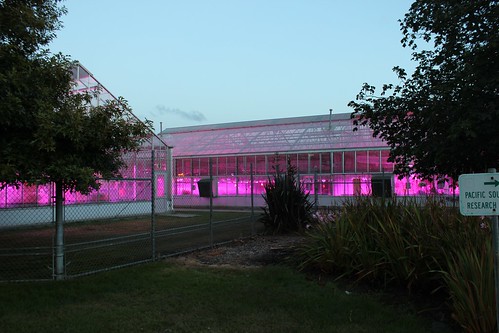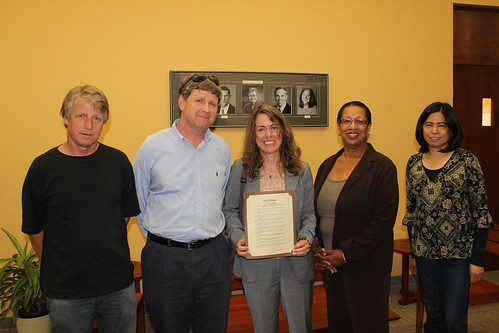
New energy efficient lights in USDA greenhouses at the Western Regional Research Center in Albany (above) will reduce greenhouse gas emissions and save about $200,000 a year in electrical costs. The City of Albany, California recently issued a proclamation recognizing USDA for installing the new LED luminaires and reducing greenhouse gas emissions. Plants in the greenhouses, used for research by Agricultural Research Service scientists, also are growing faster and producing higher yields.
This post is part of the Science Tuesday feature series on the USDA blog. Check back each week as we showcase stories and news from USDA’s rich science and research portfolio.
Sometimes greenhouse gases can be traced to greenhouses—or at least to their lighting systems.
That’s why the Albany City Council recently recognized USDA with a proclamation for reducing greenhouse gas emissions by installing energy-efficient lighting in the USDA greenhouses at the Western Regional Research Center (WRRC) in Albany, California. The greenhouses are used by scientists with USDA’s Agricultural Research Service (ARS), and the retrofit advances the goals of the city’s 2010 Climate Change Action Plan because it reduces citywide electrical use and carbon emissions.
The new LED luminaires were supplied by LumiGrow, Inc. of Novato, California. The company estimated the retrofit will prevent the release of about 105 metric tons of carbon into the atmosphere.
The new lights also will reduce energy use by 40 to 70 percent and save nearly 440,000 kiloWatt hours (kWh) of electricity per year, enough to power about 44 homes for a year. USDA is moving to LED lighting in more than a dozen other USDA facilities nationwide.
ARS expects to save about $200,000 a year on electricity costs with the new fixtures at its Albany location, according to Tara McHugh, acting WRRC Center Director.
Unlike conventional greenhouse lights, the fixtures emit a targeted mix of red and blue light that can be adjusted to elicit different plant responses. The greenhouse plants also are now growing faster and producing higher yields.
McHugh said the reduced electrical costs were anticipated, but the enhanced plant growth was an unexpected benefit that has increased the productivity of the researchers using the greenhouses. “With their plants growing faster and taking less time to reach maturity, scientists have been able to see study results sooner than they did with traditional lighting,” she said.

ARS employees (from left to right) Ron Haff, agricultural engineer, Chris Carter, secretary, Tara McHugh, acting center director, Clarice Dixson, contract specialist and Debbie Laudencia Chingcuanco, research geneticist, participated in the Albany City Council presentation.
No comments:
Post a Comment